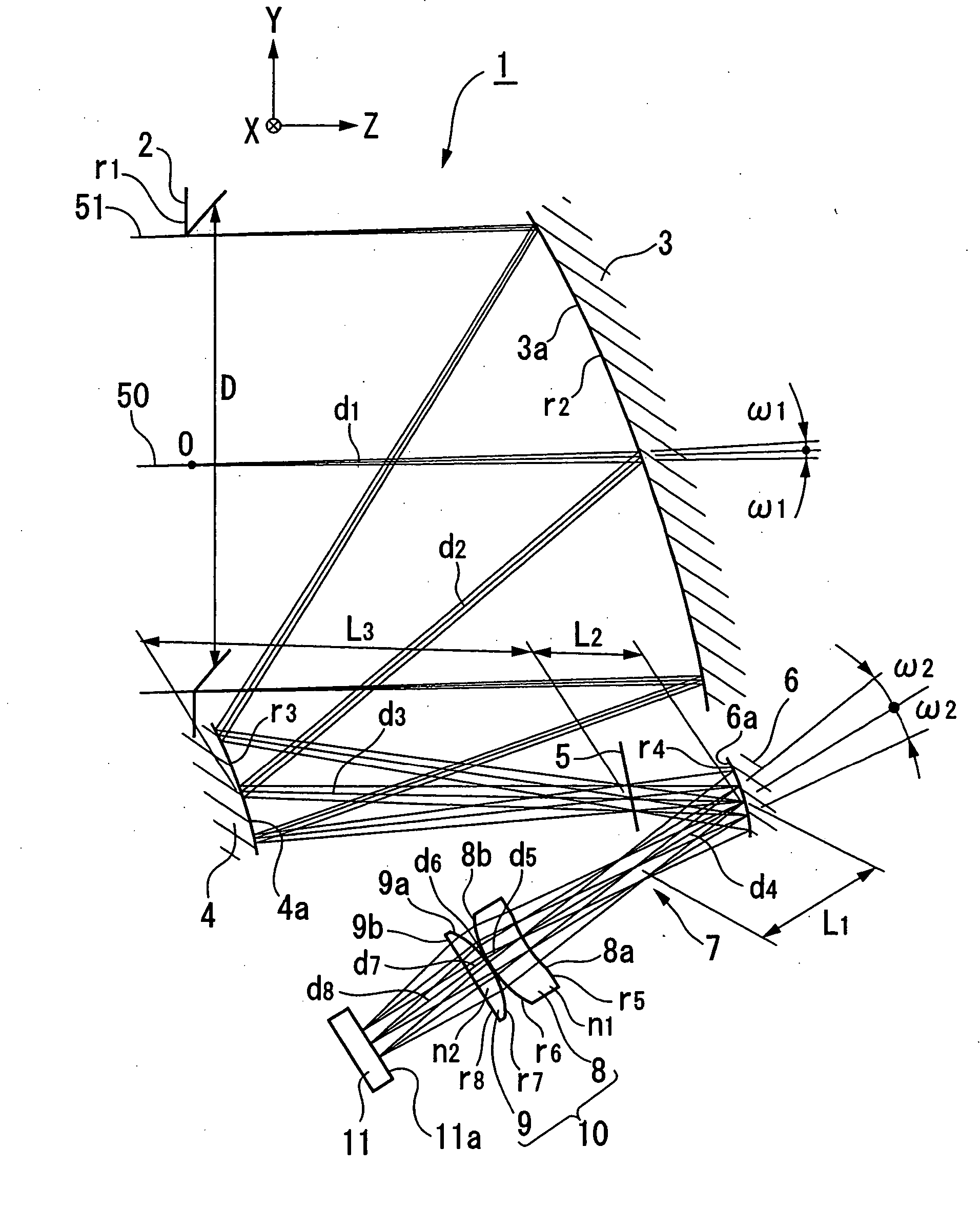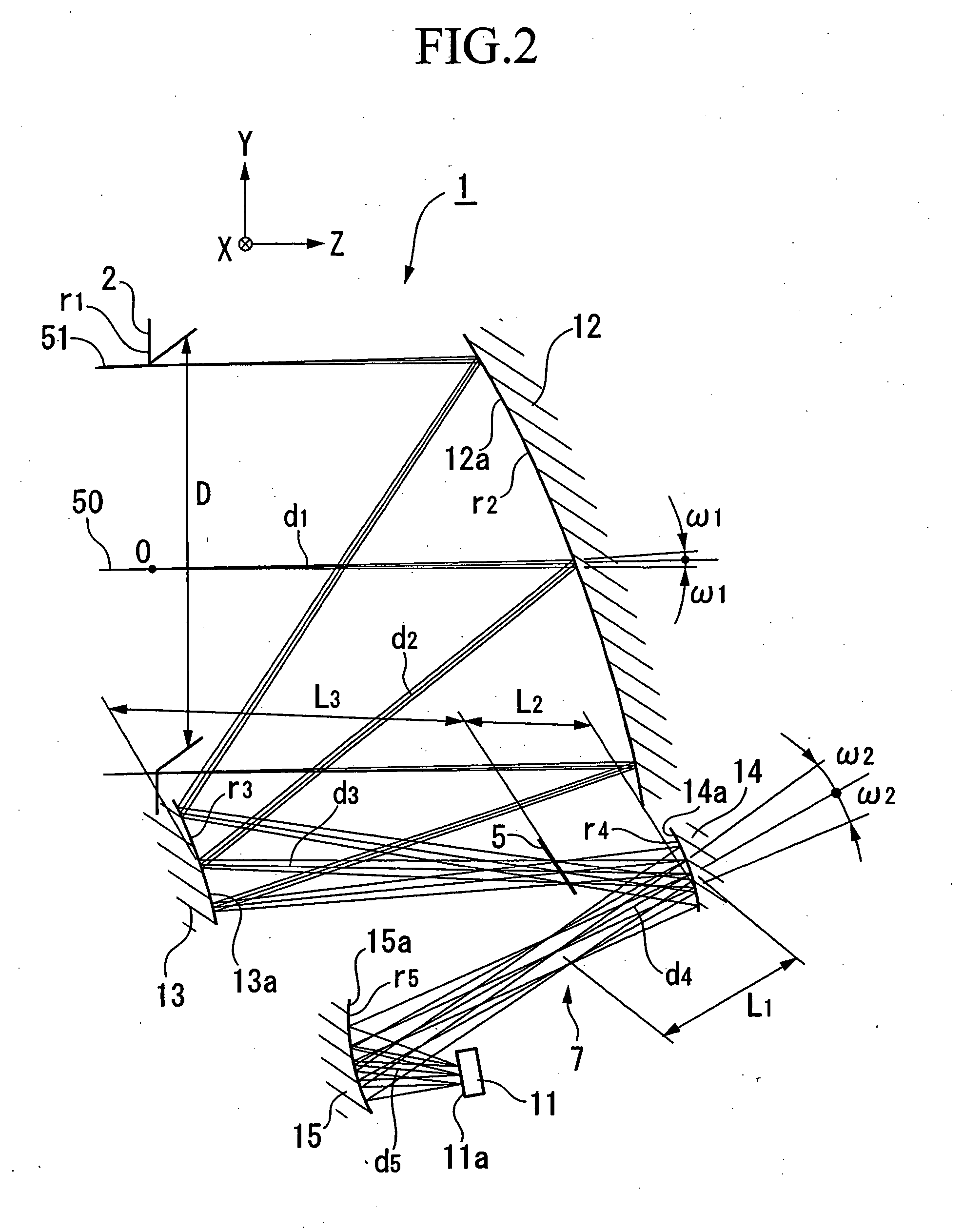Decentered optical system, light transmitting device, light receiving device, and optical system
a technology of light transmission and optical system, applied in the field of decentered optical system, light transmission device, light receiving device, optical system, can solve the problems of easy obstructing of light beam, affecting the stability of optical communication in space, and affecting the stability of optical communication, so as to achieve stable and reliable optical communication in space, the effect of light loss small and stabl
- Summary
- Abstract
- Description
- Claims
- Application Information
AI Technical Summary
Benefits of technology
Problems solved by technology
Method used
Image
Examples
first embodiment
The decentered optical system according to the first embodiment of the present invention will be explained.
FIG. 1 is a cross-sectional optical path diagram that includes the optical path on an axial principal ray for explaining an example of the decentered optical system according to a first embodiment of the present invention. Note that when the optical path has an incident field angle of 0° and an incident field angle ±ω around the axis perpendicular to the page surface, the light beam is traced by the principal ray and two characteristic rays.
The decentered optical system 1 according to a first embodiment of the present invention will be explained.
The decentered optical system 1 is for forming an image on a light receiving surface 11a after a substantially parallel incident light beam 51 (input light) is made incident on the system, and the schematic structure thereof consists of an aperture stop 2, a reflecting mirror 3 (first optical element), a reflecting mirror 4 (secon...
fourth modification
The fourth modification of the decentered optical system 1 will now be explained.
FIG. 5 is a cross-sectional optical path diagram that includes the optical path of the axial principal ray for explaining the fourth modification of the present embodiment.
Instead of the reflecting mirrors 3, 4, and 6 and the focusing device 10 of the embodiment described above, the present modification provides a Fresnel lens 24 (first optical element), a reflecting mirror 25 (second optical element), a reflecting mirror 36 (third optical element), and a Fresnel lens 27 (focusing device). Here, the coefficients of the free-formed surface and the amount of decentration of the reflecting surface 25a (decentered reflecting surface) differ only slightly from the corresponding reflecting surface 4a, and has a substantially identical effect. Thus, its explanation is omitted. Similarly, a reflecting mirror 26 having a reflecting surface 26a consisting of a rotationally asymmetric surface has a function su...
fifth modification
The fifth modification of the decentered optical system 1 will now be explained.
FIG. 6 is a cross-sectional optical path diagram that includes the optical path on the axial principal ray for explaining the fifth modification of the present embodiment.
Instead of the reflecting mirrors 3, 4, and 6 and the focusing device 10 in the embodiment described above, the present modification provides a lens 28 (first optical element), a reflecting mirror 29 (second optical element) a reflecting mirror 30 (third optical element), and a lens 31 (focusing device). In addition, instead of the Fresnel lenses 24 and 27 in the fourth modification, the configuration is substantially identical to one providing the lenses 28 and 31.
The coefficients of the free-formed surface of the reflecting surface and the amount of decentration of reflecting mirror 29 having the reflecting surface 29a (decentered active surface) and the reflecting mirror 30 having the reflecting surface 30a (an optically active...
PUM
 Login to View More
Login to View More Abstract
Description
Claims
Application Information
 Login to View More
Login to View More - R&D
- Intellectual Property
- Life Sciences
- Materials
- Tech Scout
- Unparalleled Data Quality
- Higher Quality Content
- 60% Fewer Hallucinations
Browse by: Latest US Patents, China's latest patents, Technical Efficacy Thesaurus, Application Domain, Technology Topic, Popular Technical Reports.
© 2025 PatSnap. All rights reserved.Legal|Privacy policy|Modern Slavery Act Transparency Statement|Sitemap|About US| Contact US: help@patsnap.com



